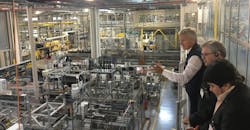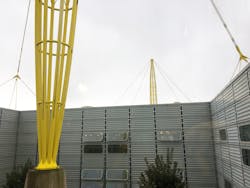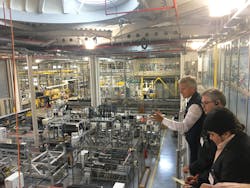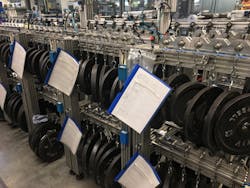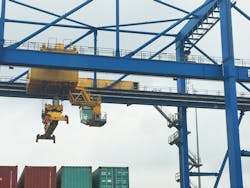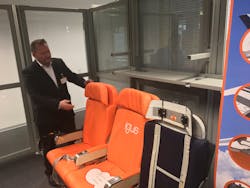Taking a Motion Plastics Field Trip with igus
For mechanical engineers trained to create and design motion control systems with conventional materials—like steel and aluminum—it is difficult to envision these systems operating with different materials. And it’s this design norm that makes it difficult for technologies like 3D printing to become a more mainstream material and manufacturing source. igus, a German-based motion control company that specializes in the creation of plastic parts for motion control applications. A recent field trip with igus highlighted some field applications using plastic motion parts to their advantage.
The field trip started at igus’ main facility in Cologne. Renowned architect Sir Nicholas Grimshaw designed the building using pylons to suspend the ceiling via tension cables. This eliminates the need for support walls in the interior of the building, creating a modular work environment that can be manipulated depending on manufacturing needs.
CEO Frank Blase hosted a tour of the facility. igus manufactures its plastic bearings, energy changes (e-chains), linear guides, and cables on site. The company hosts more than 300 injection-molding machines. It also tests all of its plastic products on site. For maximum confidence, igus runs several strength and endurance tests on its plastic parts. More than 15,000 tests per year are performed in the facility: 11,000 tribe tests and 4,100 e-chain tests, with 2 billion e-chain and chainflex cycle tests and 1 million electric measurements.
Here, e-chains are being tested back and forth on their durability to cycling. E-chains are used to house several control and energy cables in an efficient and organized manner. The e-chains’ length and size is determined by the customer. As part of the Industry 4.0 initiative in Germany, igus has added sensing to the e-chains that can predict plastic wear, breakage, temperature, and signal variances in the electrical wiring.
The test bearing facility applies heavy load to bearing turn applications to ensure they are up to the task. The bearings and linear guides for igus are being used as lightweight replacements for metal machined motion parts. The current main use of the bearings is for low maintenance and low load use cases; high load cases still benefit from the use of metal bearings and linear guides. Since the lubrication is part of the plastic’s chemical composition, they do not require lubrication maintenance and operate cleaner than metal components. This is ideal for hard-to-reach or remote areas of machinery.
The next part of the trip was a tour of real-world applications for igus’ plastic motion parts. Here, e-chains are being used in between the metal beams to store and protect the electronic cables. The crane lift spans a wide distance, and there is an e-chain on both sides to travel the electric cables from one end to the other.
In aviation and automotive applications, igus bearings are being used to help make lighter products. The motion components of seat adjustments, the rooftop of convertibles, the engine and hood, along with the trays and doors of aircraft use plastic bearings. This creates a lighter aircraft or vehicle which in turn enhances fuel efficiency. This will be an important design point as vehicles become more electric and to maximize on battery power, every ounce of weight will count.
The plastic components are also ideal for medical, food, and beverage applications. Due to the low maintenance and contamination, plastic parts are well suited for the clean environments of the medical and food industries. The above is a robotic pharmacy dispenser from Rowa BD. The machine organizes and distributes medicine automatically. The robot and medications are encased in a metal enclosure which has a display panel in front of user input. The robot uses e-chains, linear guide rails, and plastic spindle bearings for its operation.
The last part of our field trip took us to the Motek Fair in Stuttgart. One of the largest shows for motion products, igus was highlighting new products such as the Robolink line, a low-cost plastic robot featuring low wear plastic gears, and the e-chain Run Control which is an update of constant data monitoring (an upgrade from the company’s previous smart plastics).
A great example of how plastics can be used as a metal alternative, igus also sells its 3D filament directly to customers, allowing customers to create their own 3D printed parts. Here an engineer created a 3D printed plastic mechanical gripper for and saved 85% of the cost when compared to a standard robotic gripper. The new igus material iglidur 16 is the first laser sintering material for gear wheels, durable up to 1 million cycles.
